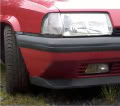Good idea, hadn't thought of that, will try it! Nice brass jets from the lotus, but I'm trying to keep the looks of the car original, jets never look right on a bx, although David's Punto jets are the neatest I've seen and barely visible, they still seem obvious, stick out like a sore thumb (no disrespect David, they are a very neat solution) but not for me now I've seen the Ford type solution - assuming I can make some that is! I rarely use the rear wash, so I was thinking of feeding one wash bottle per washer pipe (both with twin jets or fan spray - the Citroen C5 ones were good, shame about the rest of the carDefender110 wrote:BX Bandit wrote:Forming the ends could be tricky, although I thought about squeezing some brass tube in a vice to create a flat spray pattern rather than two jets, ...
squeezing the brass tube with a pair of side snips in the centre of the tube should close up the middle of the tube and leave 2 round holes either side?
Spray bar replacement - windscreen washer
-
BX Bandit

- Backslash Bandit
- Posts: 2588
- Joined: Thu Aug 31, 2006 7:46 am
- Location: Home
- My Cars: Cars
- x 3
Re: Spray bar replacement - windscreen washer
1990 BX 16V Platinum Grey
1990 BX TGD White
1960 Morris Minor Clarondon Grey
1971 Triumph 2000 Auto Valencia Blue
1990 BX TGD White
1960 Morris Minor Clarondon Grey
1971 Triumph 2000 Auto Valencia Blue
-
electrokid

- 1K Away
- Posts: 1764
- Joined: Fri May 09, 2008 2:14 pm
- Location: Woking
Re: Spray bar replacement - windscreen washer
I thought about making the jets from stainless steel tube and crimping the ends as suggested - then feeding 12 volts across the tube to make heated jets. The idea would be to use a very thin walled tube that would be of a reasonable resistance between the connections - say 0.5 ? to draw a nominal 24 amps so close to 300 watts heating for as long as the pump is operated. I did some maths the other evening calculating the resistances of some of the stst tube available on eBay and none was suitable - all too low resistance despite the fact that stst is 50 times more resistive than copper. Stst would also be more maleable - I suspect the original brass ones were probably pressed at high temperature - red hot probably.
One of my beefs with normal windscreen wash is that I think the water doesn't stay on the screen long enough to dissolve muck before it's removed by the blade so I've wondered about operating 2 pumps so that the area of the screen that has just been subject to the blade's transit should be squirted so it has more of a chance to dissolve dirt before being removed by the blade - which pump to be driven at any particular time to be determined by a sensor - probably a reed switch with a magnet on the wiper arm + relays.
It's probably quicker and easier to buy some Ford jets rather than make them - but I agree - it does look as though it should be a simple job - bet it isn't though.
One of my beefs with normal windscreen wash is that I think the water doesn't stay on the screen long enough to dissolve muck before it's removed by the blade so I've wondered about operating 2 pumps so that the area of the screen that has just been subject to the blade's transit should be squirted so it has more of a chance to dissolve dirt before being removed by the blade - which pump to be driven at any particular time to be determined by a sensor - probably a reed switch with a magnet on the wiper arm + relays.
It's probably quicker and easier to buy some Ford jets rather than make them - but I agree - it does look as though it should be a simple job - bet it isn't though.
1992 BX19 TGD estate 228K Rusty - SORNed
2002 C5 HDi SX estate
2002 C5 HDi SX estate
-
mat_fenwick

- Moderator
- Posts: 7329
- Joined: Tue Sep 20, 2005 4:08 pm
- Location: North Wales
- x 21
Re: Spray bar replacement - windscreen washer
Maybe run them in series? If that would get them in the right sort of ball park. A lot of Fords seem to be fitted with heated washers - certainly with the Focus it's part of the winter pack including the heated screen. There may be some which suit themselves to be fitted to the BX?electrokid wrote:none was suitable - all too low resistance despite the fact that stst is 50 times more resistive than copper.
That said, I'm happy with the spray bar as it is. It does need a higher concentration of screenwash than a conventional system I think, but the actual washing performance I don't have a problem with. Many seem to disagree though!
-
Way2go

- Over 2k
- Posts: 7279
- Joined: Fri Jan 13, 2006 3:15 pm
- Location: RCoBerkshire
- x 2
Re: Spray bar replacement - windscreen washer
Sounds like you could investigate a Raspberry Pi to integrate a raft of new/advanced features into our aging BX's?Electrokid wrote:One of my beefs with normal windscreen wash is that I think the water doesn't stay on the screen long enough to dissolve muck before it's removed by the blade so I've wondered about operating 2 pumps so that the area of the screen that has just been subject to the blade's transit should be squirted so it has more of a chance to dissolve dirt before being removed by the blade - which pump to be driven at any particular time to be determined by a sensor - probably a reed switch with a magnet on the wiper arm + relays.
1991 BX19GTi Auto
-
BX Bandit

- Backslash Bandit
- Posts: 2588
- Joined: Thu Aug 31, 2006 7:46 am
- Location: Home
- My Cars: Cars
- x 3
Re: Spray bar replacement - windscreen washer
I've got a xantia heated set that heat up when the rear screen demister is on but they can't be fitted without making them very obvious, and they aren't aesthetically pleasing as they are all but hidden on the xantia. I would of thought that buying a resistive wire purposefully designed to heat up at 12v wound around the tubing might work ok?
1990 BX 16V Platinum Grey
1990 BX TGD White
1960 Morris Minor Clarondon Grey
1971 Triumph 2000 Auto Valencia Blue
1990 BX TGD White
1960 Morris Minor Clarondon Grey
1971 Triumph 2000 Auto Valencia Blue
-
electrokid

- 1K Away
- Posts: 1764
- Joined: Fri May 09, 2008 2:14 pm
- Location: Woking
Re: Spray bar replacement - windscreen washer
Putting them in series could actually help even though it's only a doubling of the overall resistance so these...
http://www.ebay.co.uk/itm/10-Stainless- ... _443wt_962
if using a pair and using the whole 500mm length of each one would take 37 - 40 amps - around 500 watts total. I don't know how much current normal heated jets use but that looks practical.
Probably better to have the wire inside the tube so all the heat generated gets into the water but it would need some kind of high temp insulator wound around the wire in a loose spiral to keep it from touching the tube walls. 1 metre of stst wire 1mm in diameter would draw 13 - 15 amps - close to 200 watts. Other resistance wires are available but care would have to be taken to chose one that wouldn't corrode - at least stst is straightforward in that respect.
Yes in principle, and Raspberry Pi rather than Arduino IMHO except I just wouldn't take that approach. I'd use separate electronics for every function rather than bundling it all into a processing block - then if / when something goes wrong it's isolated to one function so determining the problem and fixing the fault would be easier.
The only things I've thought of adding to the BX (apart from adjustable wiper delay which has been solved more than adequately by Mat) would be an audible and visual extra warning linked to the lamps of death - a buzzer that has to be reset manually by pressing a button. The buzzer could also be linked to a circuit that sounds it if an indicator is left on for more than a predetermined amount of time and manually reset if the driver actually intends to leave the indicator running for that long.
http://www.ebay.co.uk/itm/10-Stainless- ... _443wt_962
if using a pair and using the whole 500mm length of each one would take 37 - 40 amps - around 500 watts total. I don't know how much current normal heated jets use but that looks practical.
Probably better to have the wire inside the tube so all the heat generated gets into the water but it would need some kind of high temp insulator wound around the wire in a loose spiral to keep it from touching the tube walls. 1 metre of stst wire 1mm in diameter would draw 13 - 15 amps - close to 200 watts. Other resistance wires are available but care would have to be taken to chose one that wouldn't corrode - at least stst is straightforward in that respect.
Yes in principle, and Raspberry Pi rather than Arduino IMHO except I just wouldn't take that approach. I'd use separate electronics for every function rather than bundling it all into a processing block - then if / when something goes wrong it's isolated to one function so determining the problem and fixing the fault would be easier.
The only things I've thought of adding to the BX (apart from adjustable wiper delay which has been solved more than adequately by Mat) would be an audible and visual extra warning linked to the lamps of death - a buzzer that has to be reset manually by pressing a button. The buzzer could also be linked to a circuit that sounds it if an indicator is left on for more than a predetermined amount of time and manually reset if the driver actually intends to leave the indicator running for that long.
1992 BX19 TGD estate 228K Rusty - SORNed
2002 C5 HDi SX estate
2002 C5 HDi SX estate
